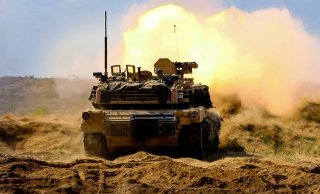AbramsX: The Army’s Newest Heavy Tank Is Unstoppable
The emergence of the AbramsX, and the many innovations being weaved into the platform, is redefining the role of the Abrams tank and heavy armor in U.S. combat operations.
Summary: The AbramsX, an advanced variant of the Abrams tank developed by General Dynamics Land Systems and the U.S. Army, introduces significant innovations to modern armored warfare. Its hybrid electric drive enhances fuel efficiency and survivability by reducing acoustic and thermal signatures, thereby improving tactical effectiveness. The incorporation of third-generation Forward Looking Infrared Sensor (FLIR) targeting systems extends the operational capabilities with longer-range, high-resolution targeting. These upgrades, emphasizing improved logistics, survivability, and lethality, transform the AbramsX into a nearly new vehicle, redefining heavy armor's role in coordination with unmanned systems and lighter attack platforms for U.S. combat operations.
In recent years, General Dynamics Land Systems (GDLS) has been working with the U.S. Army to develop and deliver several new, high-tech variants of the Abrams tank such as the v3 and v4 M1A2 SEP tanks. These new tanks incorporate several breakthrough technologies that are highly relevant to twenty-first-century armored warfare. Now, GDLS is trying to build upon these innovations with yet another, even more advanced, AbramsX variant. As a demonstrator unveiled at the 2022 Association of the United States Army Annual Symposium revealed, the AbramsX’s new innovations are expected to greatly improve the heavily armored platform’s tactical effectiveness.
Introducing AbramsX: The Future of Armored Warfare with Hybrid Electric Drive
One of the largest and potentially most impactful innovations woven into the AbramsX may be its hybrid electric drive, a propulsion system capable of significantly enhancing fuel efficiency while improving survivability with lower acoustic and thermal signatures.
General Dynamics weapons developers emphasized that, while hybrid propulsion can improve the vehicle’s environmental impact, the reason for its existence is largely tactical. Not only will a hybrid system massively reduce the logistics footprint and increase fuel efficiency, but it will also increase survivability in a number of critical respects. A smaller, leaner logistical and resupply trail creates fewer targets for an enemy and keeps more soldiers away from enemy fire. Tactically, a hybrid system also enables “silent watch,” an ability to operate sensors and weapons without emitting an acoustic or thermal signature. This improves the vehicle’s lethality and survivability and massively expands its operational envelope. These advantages are greatly maximized by third-generation Forward Looking Infrared Sensor (FLIR) targeting systems which bring much longer range and high-resolution targeting to armored offensive attack operations.
“The third generation FLIR would be incorporated into the AbramsX platform. That's a remarkable capability step above. Being a tanker, I would say that it would be noticeable what that capability is, that'll be certainly the best in the world,” Tim Reese, director of U.S. Business Development for General Dynamics Land Systems, told The National Interest in an interview.
Certainly, the v3 and v4 Abrams tanks, when all the upgrades are considered, are essentially entirely new vehicles when compared with the initial 1980s-era platform, as new sensors, weapons, data links, command and control, armor protections and on-board electrical power systems have all been completed revamped as though the platform were new.
A Special Tank?
The emergence of the AbramsX, and the many innovations being weaved into the platform, is redefining the role of the Abrams tank and heavy armor in U.S. combat operations. Indeed, it appears that heavy platforms, while operating within certain limitations, can operate in coordination with robotic vehicles, unmanned systems, and faster and lighter attack platforms to provide firepower and heavy formation support to fast-advancing units with unmatched lethality.
Kris Osborn is the defense editor for the National Interest. Osborn previously served at the Pentagon as a Highly Qualified Expert with the Office of the Assistant Secretary of the Army—Acquisition, Logistics & Technology. Osborn has also worked as an anchor and on-air military specialist at national TV networks. He has appeared as a guest military expert on Fox News, MSNBC, The Military Channel, and The History Channel. He also has a Master's Degree in Comparative Literature from Columbia University.
Image: DVIDS.

